engine overheat TOYOTA tC 2015 Owners Manual (in English)
[x] Cancel search | Manufacturer: TOYOTA, Model Year: 2015, Model line: tC, Model: TOYOTA tC 2015Pages: 492, PDF Size: 9.63 MB
Page 4 of 492

TABLE OF CONTENTSIndex
4
tC_OM_OM21057U_(U)
4-1. Maintenance and careCleaning and protecting the vehicle exterior ........... 274
Cleaning and protecting the vehicle interior ............ 278
4-2. Maintenance Maintenance requirements .................... 281
General maintenance ......... 284
Emission inspection and maintenance (I/M)
programs .......................... 288
4-3. Do-it-yourself maintenance Do-it-yourself service precautions ...................... 289
Hood................................... 294
Positioning a floor jack ....... 296
Engine compartment .......... 298
Tires ................................... 314
Tire inflation pressure......... 325
Wheels ............................... 329
Air conditioning filter ........... 332
Wireless remote control/ electronic key battery ....... 335
Checking and replacing fuses ................. 341
Light bulbs .......................... 352 5-1. Essential information
Emergency flashers ............ 364
If your vehicle needs to be towed ........................... 365
If you think something is wrong ............................ 374
Fuel pump shut off system .............................. 375
5-2. Steps to take in an emergency If a warning light turns on or a warning buzzer
sounds... .......................... 376
If you have a flat tire ........... 394
If the engine will not start .................................. 408
If the shift lever cannot be shifted from P (automatic
transmission) .................... 411
If you lose your keys ........... 412
If the electronic key does not operate properly ......... 413
If the vehicle battery is discharged .................... 417
If your vehicle overheats..... 421
If the vehicle becomes stuck ................................. 424
If your vehicle has to be stopped in an
emergency........................ 426
4Maintenance and care5When trouble arises
Page 156 of 492

156 2-1. Driving procedures
tC_OM_OM21057U_(U)
CAUTION
●On vehicles with an automatic transmission, do not shift the shift lever to P
while the vehicle is moving.
Doing so can damage the transmission and may result in a loss of vehicle\
control.
● Do not shift the shift lever to R while the vehicle is moving forward.
Doing so can damage the transmission and may result in a loss of vehicle\
control.
● Do not shift the shift lever to D (vehicles with an automatic transmission) or
1 (vehicles with a manual transmission) while the vehicle is moving back-
ward.
Doing so can damage the transmission and may result in a loss of vehicle\
control.
● Moving the shift lever to N while the vehicle is moving will disengage the
engine from the transmission. Engine braking is not available when N is
selected.
● During normal driving, do not turn off the engine. Turning the engine off
while driving will not cause loss of steering or braking control, but the
power assist to these systems will be lost. This will make it more difficult to
steer and brake, so you should pull over and stop the vehicle as soon as it
is safe to do so.
However, in the event of an emergency, such as if it becomes impossible
to stop the vehicle in the normal way: P. 426
● Use engine braking (downshift) to maintain a safe speed when driving
down a steep hill.
Using the brakes continuously may cause the brakes to overheat and lose
effectiveness. ( P. 179)
Page 158 of 492
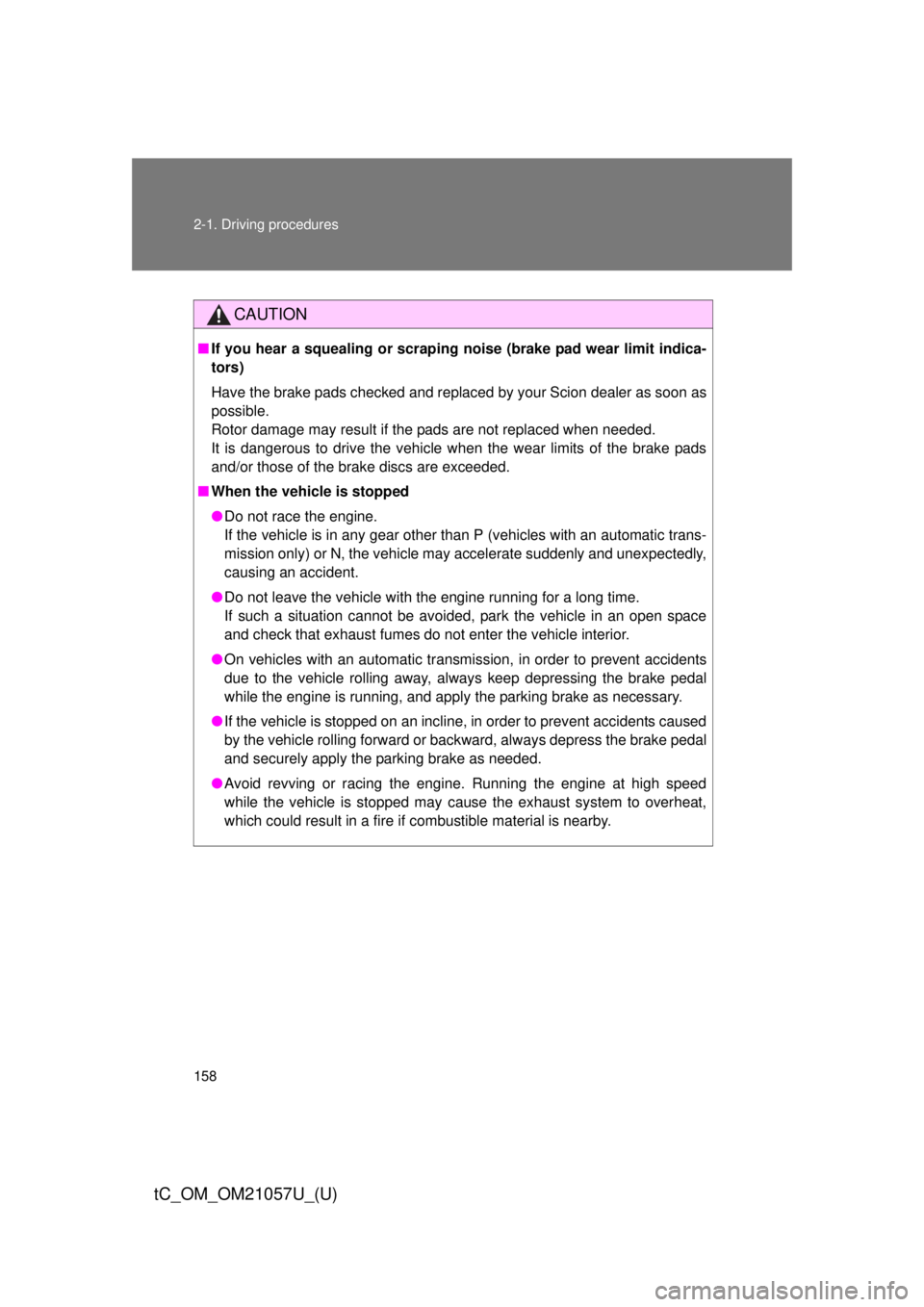
158 2-1. Driving procedures
tC_OM_OM21057U_(U)
CAUTION
■If you hear a squealing or scraping noise (brake pad wear limit indica-
tors)
Have the brake pads checked and replaced by your Scion dealer as soon as
possible.
Rotor damage may result if the pads are not replaced when needed.
It is dangerous to drive the vehicle when the wear limits of the brake pads
and/or those of the brake discs are exceeded.
■ When the vehicle is stopped
●Do not race the engine.
If the vehicle is in any gear other than P (vehicles with an automatic trans-
mission only) or N, the vehicle may accelerate suddenly and unexpectedly,
causing an accident.
● Do not leave the vehicle with the engine running for a long time.
If such a situation cannot be avoided, park the vehicle in an open space
and check that exhaust fumes do not enter the vehicle interior.
● On vehicles with an automatic transmission, in order to prevent accidents
due to the vehicle rolling away, always keep depressing the brake pedal
while the engine is running, and apply the parking brake as necessary.
● If the vehicle is stopped on an incline, in order to prevent accidents caused
by the vehicle rolling forward or backward, always depress the brake pedal
and securely apply the parking brake as needed.
● Avoid revving or racing the engine. Running the engine at high speed
while the vehicle is stopped may cause the exhaust system to overheat,
which could result in a fire if combustible material is nearby.
Page 160 of 492

160 2-1. Driving procedures
tC_OM_OM21057U_(U)
CAUTION
■Exhaust gases
Exhaust gases include harmful carbon monoxide (CO), which is colorless
and odorless. Inhaling exhaust gases may lead to death or a serious health
hazard.
●If the vehicle is in a poorly ventilated area, stop the engine. In a closed
area, such as a garage, exhaust gases may collect and enter the vehicle.
This may lead to death or a serious health hazard.
● The exhaust system should be checked occasionally. If there is a hole or
crack caused by corrosion, damage to a joint or abnormal exhaust noise,
be sure to have the vehicle inspected and repaired by your Scion dealer.
Failure to do so may allow exhaust gases to enter the vehicle, resulting in
death or a serious health hazard.
■ When taking a nap in the vehicle
Always turn the engine off. Otherwise, if you accidentally move the shift lever
or depress the accelerator pedal, this could cause an accident or fire due to
engine overheating. Additionally, if the vehicle is parked in a poorly venti-
lated area, exhaust gases may collect and enter the vehicle, leading to
death or a serious health hazard.
Page 168 of 492
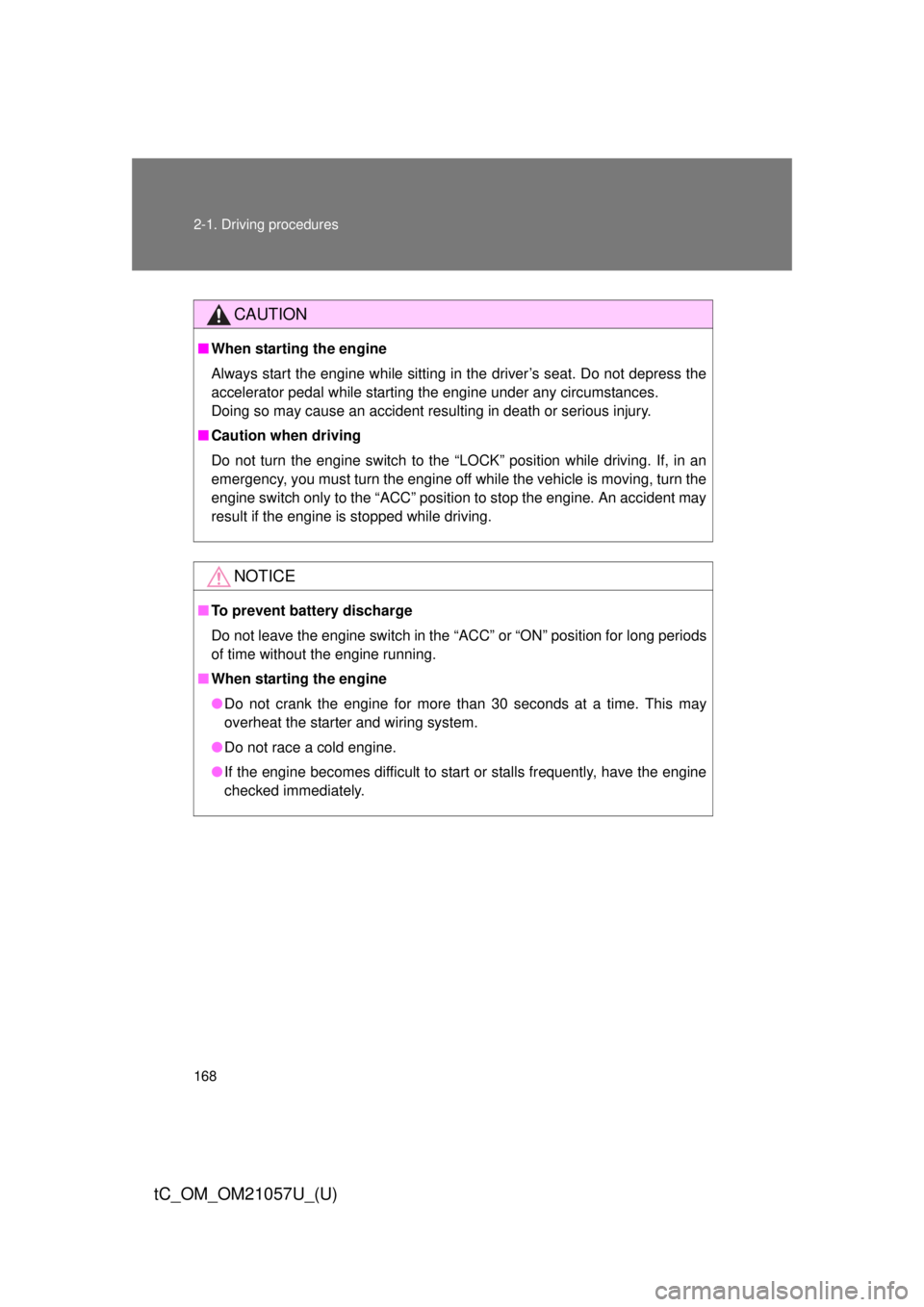
168 2-1. Driving procedures
tC_OM_OM21057U_(U)
CAUTION
■When starting the engine
Always start the engine while sitting in the driver’s seat. Do not depress the
accelerator pedal while starting the engine under any circumstances.
Doing so may cause an accident resulting in death or serious injury.
■ Caution when driving
Do not turn the engine switch to the “LOCK” position while driving. If, in an
emergency, you must turn the engine off while the vehicle is moving, turn the
engine switch only to the “ACC” position to stop the engine. An accident may
result if the engine is stopped while driving.
NOTICE
■To prevent battery discharge
Do not leave the engine switch in the “ACC” or “ON” position for long periods
of time without the engine running.
■ When starting the engine
●Do not crank the engine for more than 30 seconds at a time. This may
overheat the starter and wiring system.
● Do not race a cold engine.
● If the engine becomes difficult to start or stalls frequently, have the engine
checked immediately.
Page 175 of 492
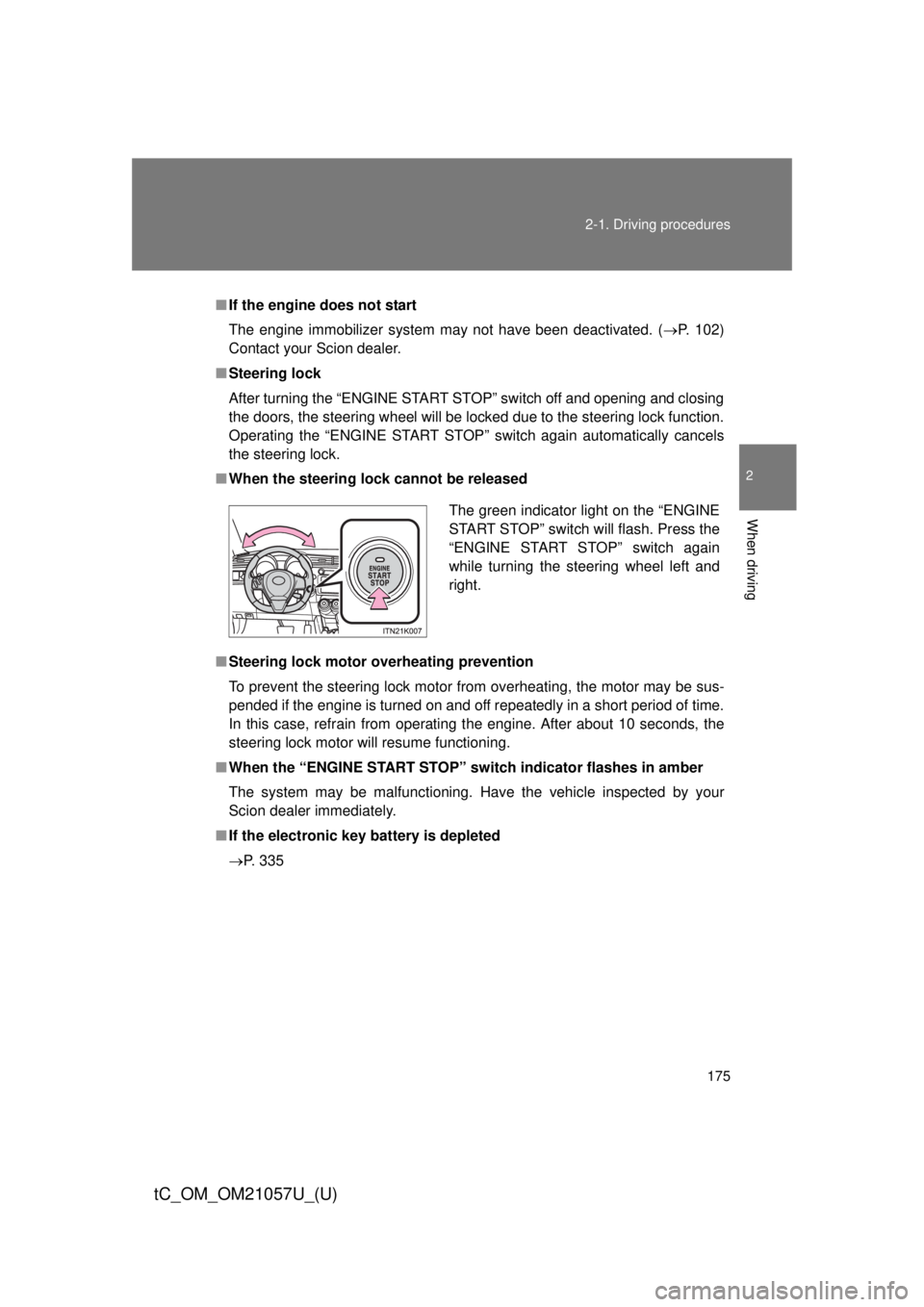
175
2-1. Driving procedures
2
When driving
tC_OM_OM21057U_(U)
■
If the engine does not start
The engine immobilizer system may not have been deactivated. ( P. 102)
Contact your Scion dealer.
■ Steering lock
After turning the “ENGINE START STOP” switch off and opening and closing
the doors, the steering wheel will be locked due to the steering lock function.
Operating the “ENGINE START STOP” switch again automatically cancels
the steering lock.
■ When the steering lock cannot be released
■ Steering lock motor overheating prevention
To prevent the steering lock motor from overheating, the motor may be sus-
pended if the engine is turned on and off repeatedly in a short period of time.
In this case, refrain from operating the engine. After about 10 seconds, the
steering lock motor will resume functioning.
■ When the “ENGINE START STOP” switch indicator flashes in amber
The system may be malfunctioning. Have the vehicle inspected by your
Scion dealer immediately.
■ If the electronic key battery is depleted
P. 335
The green indicator light on the “ENGINE
START STOP” switch will flash. Press the
“ENGINE START STOP” switch again
while turning the steering wheel left and
right.
Page 217 of 492
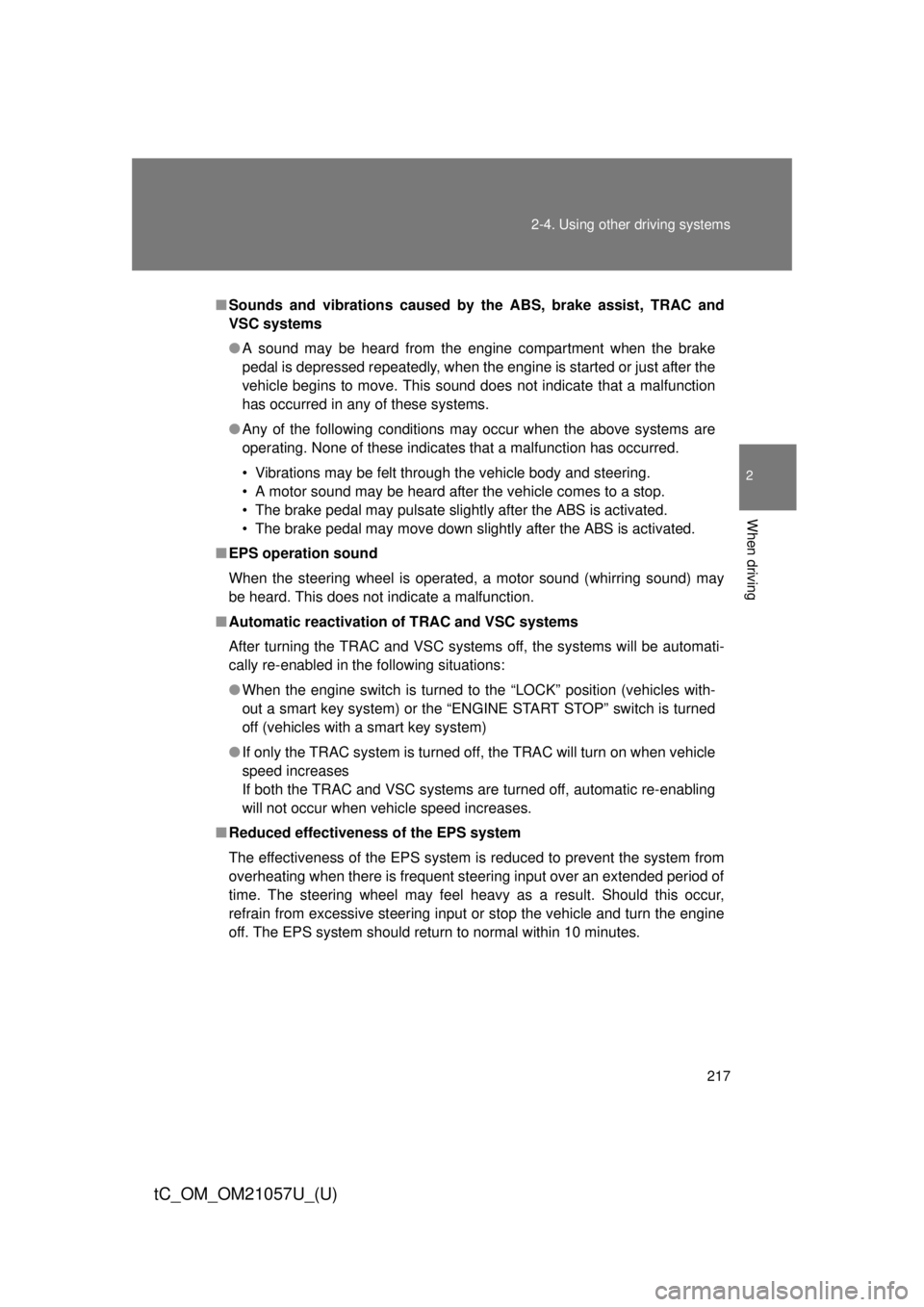
217
2-4. Using other
driving systems
2
When driving
tC_OM_OM21057U_(U)
■Sounds and vibrations caused by the ABS, brake assist, TRAC and
VSC systems
●A sound may be heard from the engine compartment when the brake
pedal is depressed repeatedly, when the engine is started or just after the
vehicle begins to move. This sound does not indicate that a malfunction
has occurred in any of these systems.
● Any of the following conditions may occur when the above systems are
operating. None of these indicates that a malfunction has occurred.
• Vibrations may be felt through the vehicle body and steering.
• A motor sound may be heard after the vehicle comes to a stop.
• The brake pedal may pulsate slightly after the ABS is activated.
• The brake pedal may move down slightly after the ABS is activated.
■ EPS operation sound
When the steering wheel is operated, a motor sound (whirring sound) may
be heard. This does not indicate a malfunction.
■ Automatic reactivation of TRAC and VSC systems
After turning the TRAC and VSC systems off, the systems will be automati-
cally re-enabled in the following situations:
●When the engine switch is turned to the “LOCK” position (vehicles with-
out a smart key system) or the “ENGINE START STOP” switch is turned
off (vehicles with a smart key system)
● If only the TRAC system is turned off, the TRAC will turn on when vehicle
speed increases
If both the TRAC and VSC systems are turned off, automatic re-enabling
will not occur when vehicle speed increases.
■ Reduced effectiveness of the EPS system
The effectiveness of the EPS system is reduced to prevent the system from
overheating when there is frequent steering input over an extended period of
time. The steering wheel may feel heavy as a result. Should this occur,
refrain from excessive steering input or stop the vehicle and turn the engine
off. The EPS system should return to normal within 10 minutes.
Page 263 of 492
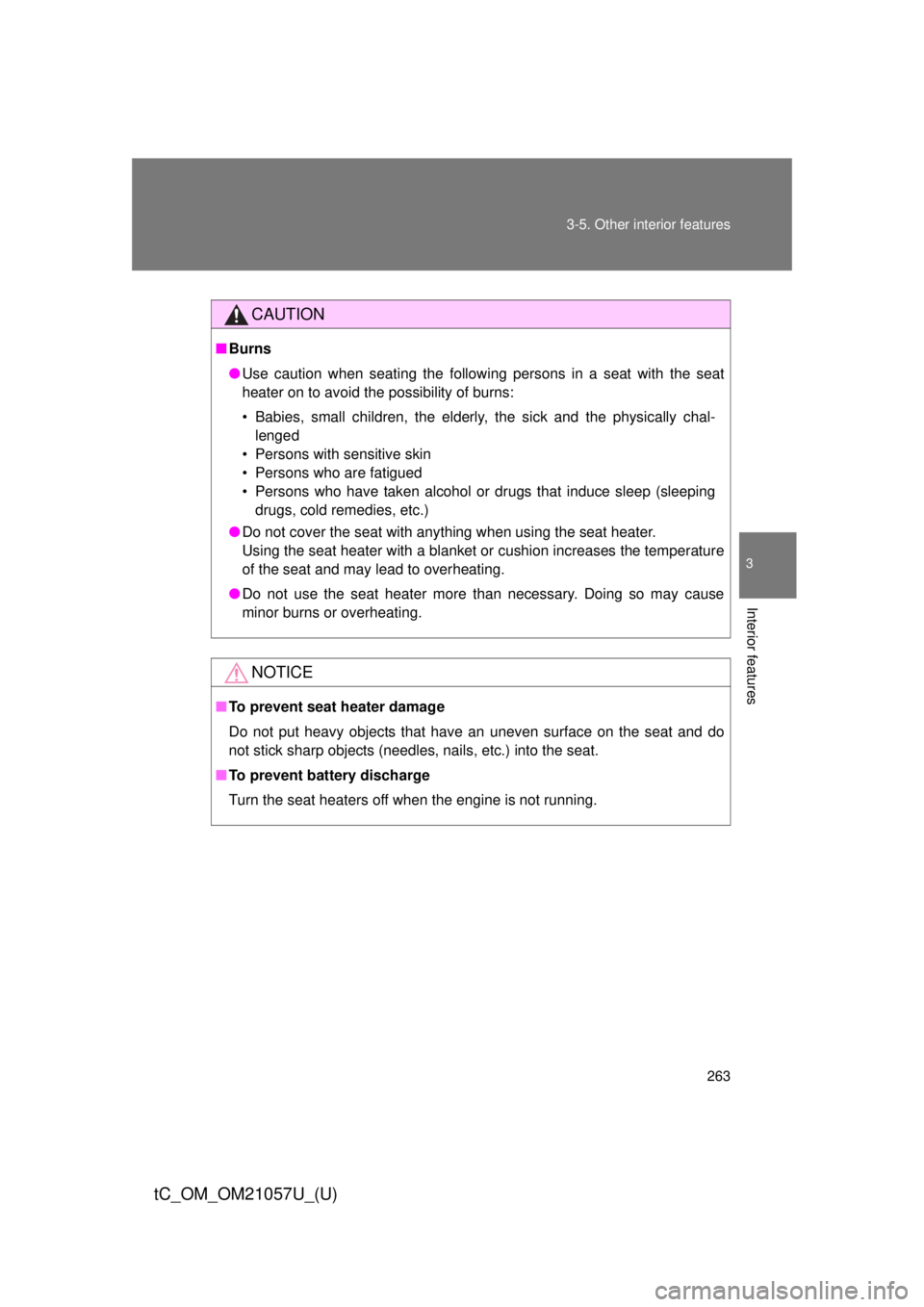
263
3-5. Other interior features
3
Interior features
tC_OM_OM21057U_(U)
CAUTION
■
Burns
●Use caution when seating the following persons in a seat with the seat
heater on to avoid the possibility of burns:
• Babies, small children, the elderly, the sick and the physically chal-
lenged
• Persons with sensitive skin
• Persons who are fatigued
• Persons who have taken alcohol or drugs that induce sleep (sleeping drugs, cold remedies, etc.)
● Do not cover the seat with anything when using the seat heater.
Using the seat heater with a blanket or cushion increases the temperature
of the seat and may lead to overheating.
● Do not use the seat heater more than necessary. Doing so may cause
minor burns or overheating.
NOTICE
■To prevent seat heater damage
Do not put heavy objects that have an uneven surface on the seat and do
not stick sharp objects (needles, nails, etc.) into the seat.
■ To prevent battery discharge
Turn the seat heaters off when the engine is not running.
Page 363 of 492
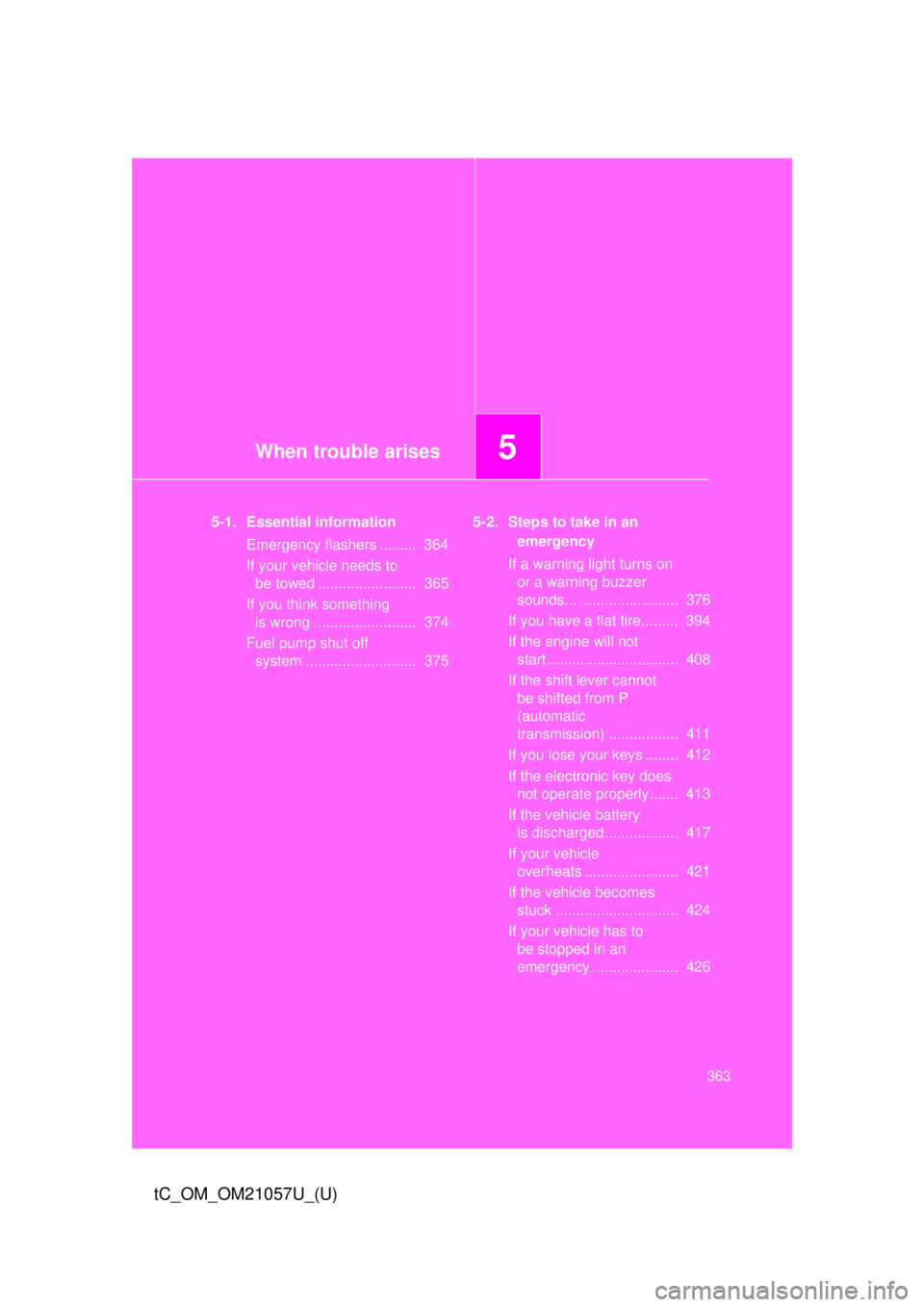
When trouble arises5
363
tC_OM_OM21057U_(U)
5-1. Essential informationEmergency flashers ......... 364
If your vehicle needs to be towed ........................ 365
If you think something is wrong ......................... 374
Fuel pump shut off system ........................... 375 5-2. Steps to take in an
emergency
If a warning light turns on or a warning buzzer
sounds... ....................... 376
If you have a flat tire......... 394
If the engine will not start ................................ 408
If the shift lever cannot be shifted from P
(automatic
transmission) ................. 411
If you lose your keys ........ 412
If the electronic key does not operate properly....... 413
If the vehicle battery is discharged .................. 417
If your vehicle overheats ....................... 421
If the vehicle becomes stuck .............................. 424
If your vehicle has to be stopped in an
emergency ..................... 426
Page 380 of 492
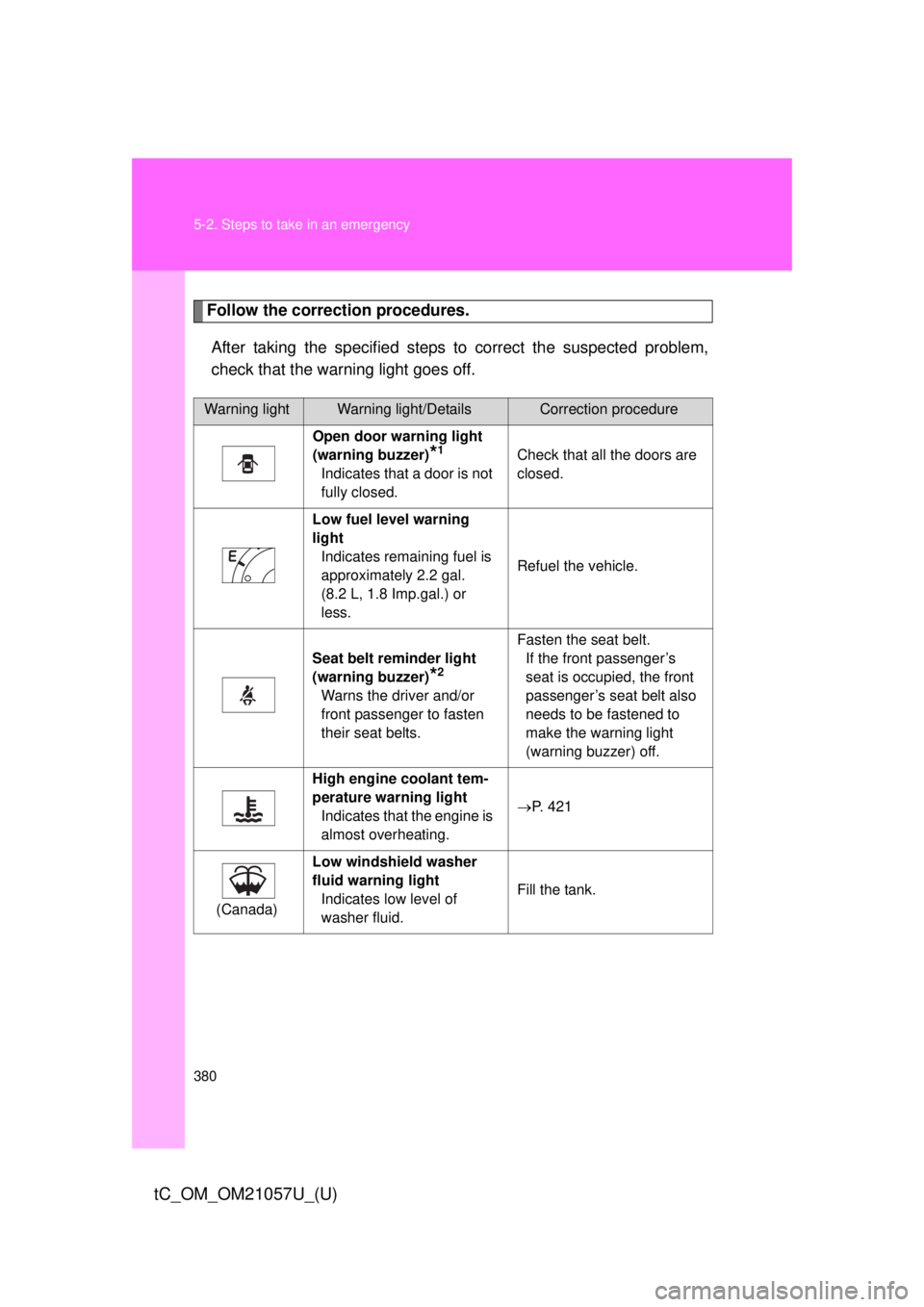
380 5-2. Steps to take in an emergency
tC_OM_OM21057U_(U)
Follow the correction procedures.After taking the specified steps to correct the suspected problem,
check that the warning light goes off.
Warning lightWarning light/DetailsCorrection procedure
Open door warning light
(warning buzzer)
*1
Indicates that a door is not
fully closed. Check that all the doors are
closed.
Low fuel level warning
light Indicates remaining fuel is
approximately 2.2 gal.
(8.2 L, 1.8 Imp.gal.) or
less. Refuel the vehicle.
Seat belt reminder light
(warning buzzer)
*2
Warns the driver and/or
front passenger to fasten
their seat belts. Fasten the seat belt.
If the front passenger’s
seat is occupied, the front
passenger’s seat belt also
needs to be fastened to
make the warning light
(warning buzzer) off.
High engine coolant tem-
perature warning light Indicates that the engine is
almost overheating. P. 421
(Canada) Low windshield washer
fluid warning light
Indicates low level of
washer fluid. Fill the tank.